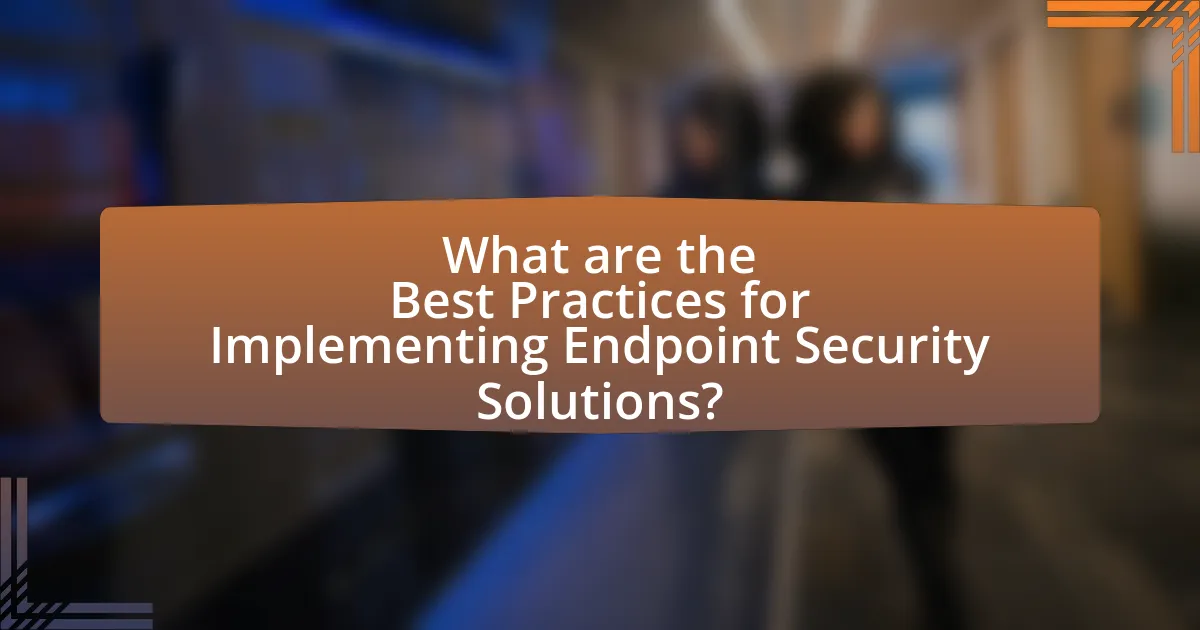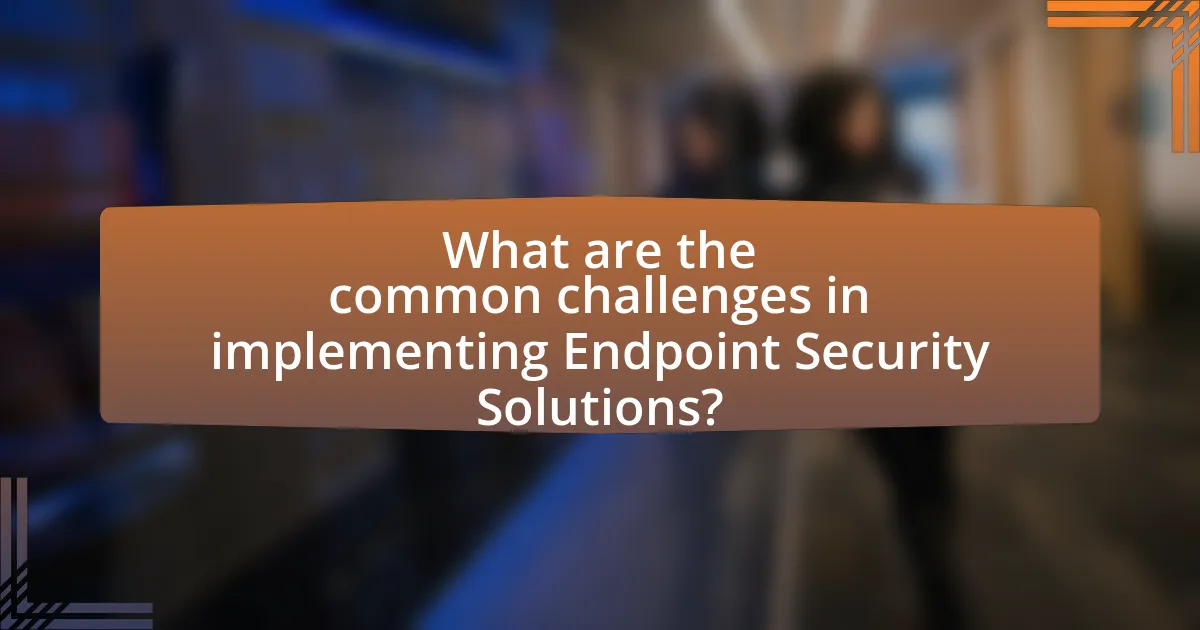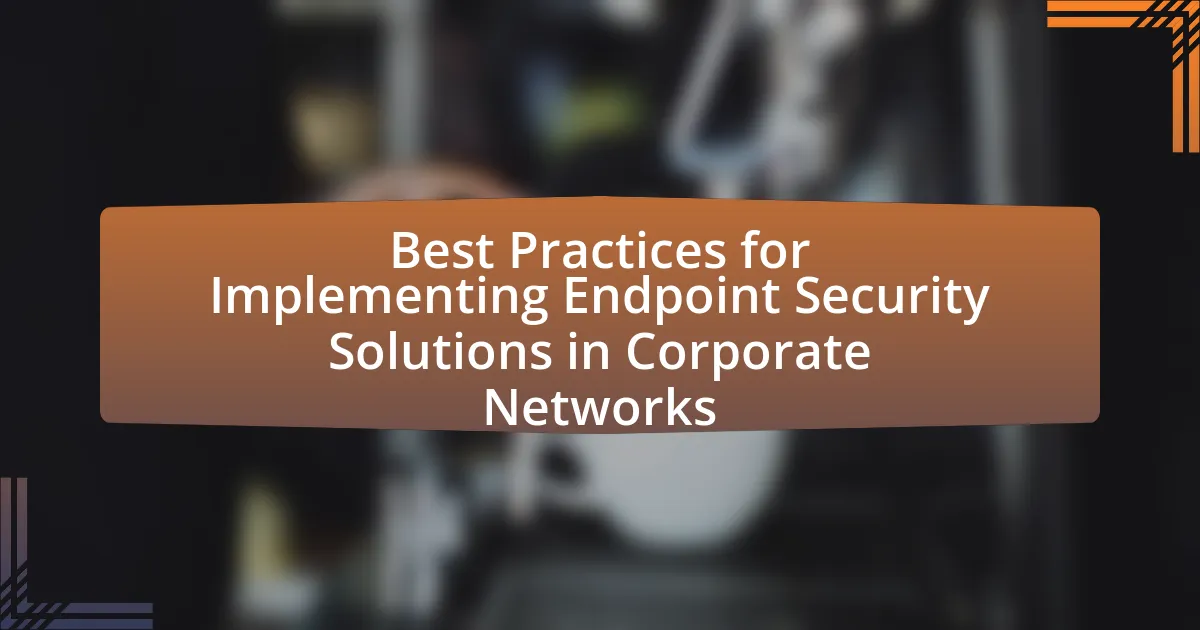Endpoint security solutions are critical measures designed to protect devices such as computers, mobile devices, and servers from cyber threats. This article outlines best practices for implementing these solutions in corporate networks, emphasizing the importance of comprehensive security measures, including antivirus software, firewalls, and data encryption. It discusses how endpoint security protects against various threats, the key components involved, and the necessity of ongoing maintenance and user training. Additionally, the article highlights the risks organizations face without proper endpoint security and provides strategies for effective deployment and user acceptance, ensuring robust protection of sensitive data and compliance with regulatory requirements.

What are Endpoint Security Solutions?
Endpoint security solutions are security measures designed to protect endpoints, such as computers, mobile devices, and servers, from cyber threats. These solutions typically include antivirus software, firewalls, intrusion detection systems, and data encryption, which work together to prevent unauthorized access and mitigate risks associated with malware, ransomware, and other cyber attacks. According to a report by Cybersecurity Ventures, global spending on endpoint security is projected to reach $20 billion by 2023, highlighting the increasing importance of these solutions in safeguarding corporate networks.
How do Endpoint Security Solutions protect corporate networks?
Endpoint Security Solutions protect corporate networks by monitoring, detecting, and responding to threats at the device level. These solutions utilize advanced technologies such as antivirus software, firewalls, intrusion detection systems, and behavioral analysis to identify and mitigate potential security breaches. For instance, according to a report by Gartner, organizations that implement endpoint security solutions can reduce the risk of data breaches by up to 70%. This effectiveness is attributed to real-time threat intelligence and automated responses that prevent malware and unauthorized access, thereby safeguarding sensitive corporate data and maintaining network integrity.
What types of threats do Endpoint Security Solutions defend against?
Endpoint Security Solutions defend against various types of threats, including malware, ransomware, phishing attacks, and unauthorized access. These solutions utilize advanced detection techniques, such as behavioral analysis and machine learning, to identify and mitigate these threats effectively. For instance, according to a report by Cybersecurity Ventures, ransomware attacks are projected to cost businesses over $20 billion by 2021, highlighting the critical need for robust endpoint security measures. Additionally, the 2020 Verizon Data Breach Investigations Report indicates that 22% of data breaches involved phishing, underscoring the importance of endpoint security in protecting against such tactics.
What are the key components of Endpoint Security Solutions?
The key components of Endpoint Security Solutions include antivirus software, firewalls, intrusion detection systems, data encryption, and endpoint detection and response (EDR) tools. Antivirus software protects against malware by scanning and removing harmful programs, while firewalls monitor and control incoming and outgoing network traffic based on predetermined security rules. Intrusion detection systems identify and respond to potential threats in real-time, enhancing overall security posture. Data encryption secures sensitive information by converting it into unreadable formats, ensuring that only authorized users can access it. EDR tools provide advanced threat detection and response capabilities, allowing organizations to quickly identify and mitigate security incidents. These components collectively form a robust defense against various cyber threats, making them essential for effective endpoint security.
Why is implementing Endpoint Security Solutions crucial for businesses?
Implementing Endpoint Security Solutions is crucial for businesses because it protects sensitive data and systems from cyber threats. With the rise in remote work and the increasing number of devices accessing corporate networks, endpoints have become prime targets for cyberattacks. According to a report by Cybersecurity Ventures, global cybercrime damages are projected to reach $10.5 trillion annually by 2025, highlighting the urgent need for robust endpoint security measures. Effective endpoint security solutions help mitigate risks by providing real-time threat detection, automated responses to incidents, and comprehensive monitoring of all devices connected to the network.
What risks do organizations face without Endpoint Security?
Organizations without Endpoint Security face significant risks, including increased vulnerability to cyberattacks, data breaches, and malware infections. Without proper endpoint protection, devices such as laptops, smartphones, and servers become easy targets for attackers, leading to potential unauthorized access to sensitive information. According to a report by Cybersecurity Ventures, global cybercrime damages are expected to reach $10.5 trillion annually by 2025, highlighting the financial impact of inadequate security measures. Furthermore, the Ponemon Institute’s 2021 Cost of a Data Breach Report indicates that the average cost of a data breach is $4.24 million, underscoring the financial repercussions organizations may face without effective endpoint security in place.
How can Endpoint Security Solutions enhance compliance and data protection?
Endpoint Security Solutions enhance compliance and data protection by providing robust mechanisms for monitoring, managing, and securing endpoints against threats. These solutions enforce security policies that align with regulatory requirements, such as GDPR and HIPAA, ensuring that sensitive data is adequately protected. For instance, endpoint security tools can implement encryption, access controls, and real-time threat detection, which are essential for maintaining compliance with data protection laws. Additionally, according to a report by the Ponemon Institute, organizations that utilize endpoint security solutions experience a 30% reduction in data breaches, demonstrating their effectiveness in safeguarding data and enhancing compliance.

What are the Best Practices for Implementing Endpoint Security Solutions?
The best practices for implementing endpoint security solutions include conducting a thorough risk assessment, deploying comprehensive security software, ensuring regular updates and patch management, enforcing strong access controls, and providing ongoing employee training. Conducting a risk assessment helps identify vulnerabilities specific to the organization, allowing for tailored security measures. Comprehensive security software, such as antivirus and anti-malware programs, protects against a wide range of threats. Regular updates and patch management are crucial, as 60% of breaches exploit known vulnerabilities that could be mitigated through timely updates. Strong access controls, including multi-factor authentication, limit unauthorized access to sensitive data. Finally, ongoing employee training is essential, as human error accounts for 95% of cybersecurity incidents, emphasizing the need for awareness and best practices among staff.
How should organizations assess their security needs before implementation?
Organizations should assess their security needs by conducting a comprehensive risk assessment that identifies vulnerabilities, threats, and the potential impact of security breaches. This process involves evaluating existing security measures, understanding the specific data and assets that need protection, and analyzing the regulatory requirements relevant to their industry. For instance, a 2021 report by Cybersecurity & Infrastructure Security Agency (CISA) emphasizes that organizations should prioritize identifying critical assets and potential attack vectors to tailor their security strategies effectively. By systematically analyzing these factors, organizations can make informed decisions about the necessary security solutions to implement, ensuring they address their unique risks and compliance obligations.
What factors should be considered in a risk assessment?
In a risk assessment, factors such as asset identification, threat analysis, vulnerability assessment, impact evaluation, and likelihood determination should be considered. Asset identification involves cataloging all critical assets within the corporate network, including hardware, software, and data. Threat analysis examines potential threats that could exploit vulnerabilities, such as malware or insider threats. Vulnerability assessment identifies weaknesses in the system that could be targeted. Impact evaluation assesses the potential consequences of a successful attack on these assets, while likelihood determination estimates the probability of such threats occurring. These factors collectively inform the overall risk level and help prioritize security measures effectively.
How can businesses prioritize their security requirements?
Businesses can prioritize their security requirements by conducting a comprehensive risk assessment to identify vulnerabilities and potential threats. This assessment allows organizations to evaluate the impact and likelihood of various security risks, enabling them to allocate resources effectively. According to the National Institute of Standards and Technology (NIST), a structured approach to risk management helps organizations focus on the most critical assets and threats, ensuring that security measures are aligned with business objectives. By prioritizing based on risk levels, businesses can implement targeted security solutions that address their most pressing vulnerabilities, thereby enhancing their overall security posture.
What steps are involved in deploying Endpoint Security Solutions?
The steps involved in deploying Endpoint Security Solutions include assessing the current security posture, selecting appropriate security solutions, planning the deployment strategy, configuring the solutions, conducting pilot testing, rolling out the solutions across the network, and continuously monitoring and updating the security measures.
Assessing the current security posture involves evaluating existing vulnerabilities and risks within the network. Selecting appropriate security solutions requires identifying software and hardware that meet the organization’s specific needs, such as antivirus, firewalls, and intrusion detection systems. Planning the deployment strategy entails outlining timelines, resources, and responsibilities for the implementation process.
Configuring the solutions involves setting up the software and hardware according to best practices and organizational policies. Conducting pilot testing allows for identifying any issues before full deployment. Rolling out the solutions across the network ensures that all endpoints are protected. Finally, continuously monitoring and updating the security measures is essential to adapt to new threats and vulnerabilities, ensuring ongoing protection.
How can organizations ensure a smooth installation process?
Organizations can ensure a smooth installation process by conducting thorough pre-installation planning and testing. This involves assessing the existing infrastructure, identifying potential compatibility issues, and preparing a detailed implementation plan that includes timelines and resource allocation. According to a study by the Ponemon Institute, organizations that engage in comprehensive planning reduce installation-related disruptions by up to 30%. Additionally, providing adequate training for staff and establishing clear communication channels during the installation phase further enhances the likelihood of a seamless deployment.
What training is necessary for staff during implementation?
Staff training during the implementation of endpoint security solutions is essential to ensure effective usage and compliance. This training should include comprehensive education on the specific security tools being deployed, understanding potential threats, and best practices for maintaining security protocols. Additionally, staff should receive training on incident response procedures and the importance of reporting suspicious activities. Research indicates that organizations with well-trained staff experience a 70% reduction in security incidents, highlighting the critical role of training in enhancing overall security posture.

What are the common challenges in implementing Endpoint Security Solutions?
Common challenges in implementing Endpoint Security Solutions include integration with existing systems, user resistance, and the complexity of managing diverse devices. Integration issues arise when new security solutions do not seamlessly work with legacy systems, leading to potential vulnerabilities. User resistance often stems from concerns about performance impacts and changes in workflow, which can hinder adoption. Additionally, the complexity of managing a wide range of devices, including mobile and IoT devices, complicates the enforcement of consistent security policies. According to a report by Gartner, 60% of organizations face difficulties in integrating endpoint security with their existing IT infrastructure, highlighting the prevalence of these challenges.
How can organizations overcome resistance to new security measures?
Organizations can overcome resistance to new security measures by fostering a culture of security awareness and involving employees in the implementation process. Engaging staff through training sessions and open discussions about the importance of security measures helps to build understanding and buy-in. Research indicates that organizations with comprehensive security training programs experience 70% fewer security incidents, highlighting the effectiveness of education in mitigating resistance. Additionally, providing clear communication about the benefits and necessity of new measures can alleviate concerns and encourage acceptance among employees.
What strategies can be employed to promote user acceptance?
To promote user acceptance of endpoint security solutions in corporate networks, organizations can employ strategies such as comprehensive training programs, clear communication of benefits, and involving users in the implementation process. Comprehensive training programs ensure that users understand how to use the security tools effectively, which can increase their confidence and willingness to adopt the solutions. Clear communication of benefits, such as enhanced data protection and reduced risk of breaches, helps users see the value in the new systems. Involving users in the implementation process, such as gathering feedback and addressing concerns, fosters a sense of ownership and acceptance. Research indicates that user involvement in technology adoption significantly increases acceptance rates, as seen in studies published in the Journal of Information Technology, which highlight the importance of user engagement in successful technology implementation.
How can businesses address compatibility issues with existing systems?
Businesses can address compatibility issues with existing systems by conducting thorough compatibility assessments before implementing new endpoint security solutions. This involves evaluating the current infrastructure, identifying potential conflicts, and ensuring that new solutions can integrate seamlessly with existing software and hardware. For instance, a study by Gartner indicates that 70% of organizations experience integration challenges when deploying new technologies, highlighting the importance of pre-implementation analysis. By utilizing compatibility testing tools and engaging in pilot programs, businesses can mitigate risks and ensure that new security measures enhance rather than disrupt their operational capabilities.
What ongoing maintenance is required for Endpoint Security Solutions?
Ongoing maintenance for Endpoint Security Solutions includes regular updates, monitoring, and incident response. Regular updates ensure that the security software is equipped with the latest threat definitions and patches, which is crucial as cyber threats evolve rapidly. Monitoring involves continuous assessment of endpoint activities to detect anomalies or breaches in real-time, allowing for swift action. Incident response is essential for addressing any security incidents that occur, ensuring that the organization can mitigate damage and recover effectively. These maintenance activities are supported by industry standards, such as the National Institute of Standards and Technology (NIST) guidelines, which emphasize the importance of proactive security measures in safeguarding corporate networks.
How often should security updates and patches be applied?
Security updates and patches should be applied at least monthly, with critical updates implemented as soon as they are released. Regular monthly updates help mitigate vulnerabilities that could be exploited by attackers, while immediate application of critical patches addresses urgent security threats. According to the Cybersecurity and Infrastructure Security Agency (CISA), timely patch management is essential for maintaining the security posture of corporate networks, as unpatched systems are prime targets for cyberattacks.
What monitoring practices should be established post-implementation?
Post-implementation, organizations should establish continuous monitoring practices that include real-time threat detection, regular security audits, and user activity monitoring. Real-time threat detection utilizes advanced analytics and machine learning to identify anomalies and potential breaches as they occur, ensuring immediate response to threats. Regular security audits involve systematic evaluations of the security posture, identifying vulnerabilities and compliance with security policies, which is essential for maintaining robust endpoint security. User activity monitoring tracks user behavior to detect any unauthorized access or suspicious activities, providing insights into potential insider threats. These practices are supported by industry standards, such as the NIST Cybersecurity Framework, which emphasizes the importance of ongoing monitoring to mitigate risks effectively.
What are the key metrics for evaluating the effectiveness of Endpoint Security Solutions?
Key metrics for evaluating the effectiveness of Endpoint Security Solutions include detection rate, response time, false positive rate, and user impact. The detection rate measures the percentage of threats identified by the solution, with a higher rate indicating better performance; for instance, a solution with a detection rate above 95% is generally considered effective. Response time assesses how quickly the solution can react to identified threats, with faster response times minimizing potential damage. The false positive rate indicates the frequency of incorrect threat alerts, where a lower rate signifies a more reliable solution. Lastly, user impact evaluates how the security measures affect end-user productivity, aiming for minimal disruption while maintaining security. These metrics collectively provide a comprehensive view of an endpoint security solution’s effectiveness in protecting corporate networks.
How can organizations measure incident response times?
Organizations can measure incident response times by tracking the duration from the moment an incident is detected until it is resolved. This can be achieved through the implementation of incident management systems that log timestamps for detection, acknowledgment, investigation, and resolution phases. According to the Ponemon Institute’s “Cost of a Data Breach Report 2021,” organizations that effectively track these metrics can reduce their average response time significantly, which is crucial for minimizing damage and recovery costs.
What indicators reflect the overall security posture of the network?
Indicators that reflect the overall security posture of the network include the number of detected vulnerabilities, the frequency of security incidents, and the effectiveness of security controls. The presence of unpatched software vulnerabilities can indicate weaknesses in the network, as studies show that 60% of breaches exploit known vulnerabilities. Additionally, monitoring the frequency and severity of security incidents helps assess the network’s resilience; for instance, organizations that experience frequent phishing attacks may need to enhance their user training and email filtering systems. Lastly, the effectiveness of security controls, such as firewalls and intrusion detection systems, can be evaluated through metrics like the rate of false positives and the time taken to respond to incidents, which are critical for maintaining a robust security posture.
What practical tips can enhance the implementation of Endpoint Security Solutions?
To enhance the implementation of Endpoint Security Solutions, organizations should prioritize regular updates and patch management. Keeping software and security solutions up to date mitigates vulnerabilities that cyber attackers exploit; for instance, a report by the Cybersecurity and Infrastructure Security Agency (CISA) indicates that 85% of successful breaches involve unpatched vulnerabilities. Additionally, implementing a robust user training program on security best practices can significantly reduce human error, which is responsible for 95% of cybersecurity incidents according to the 2021 Verizon Data Breach Investigations Report. Furthermore, deploying multi-factor authentication (MFA) adds an extra layer of security, making unauthorized access more difficult. By focusing on these practical tips, organizations can strengthen their endpoint security posture effectively.
